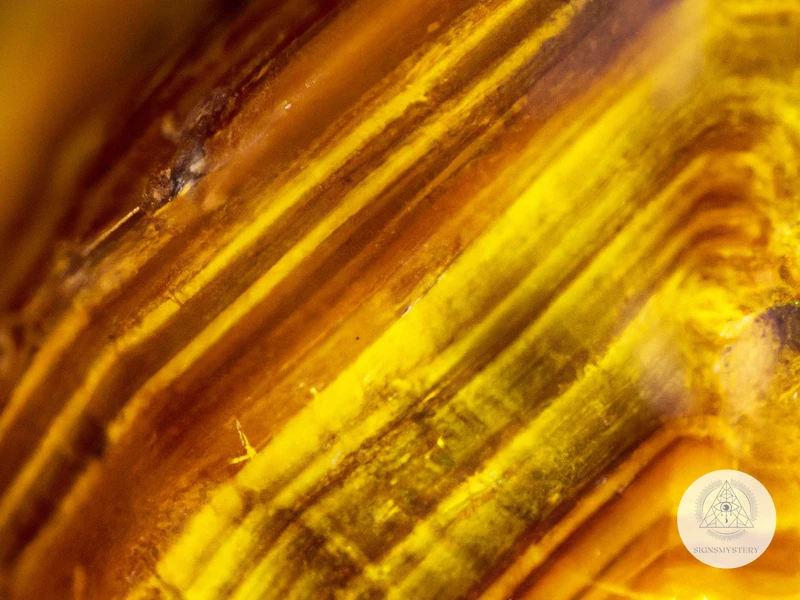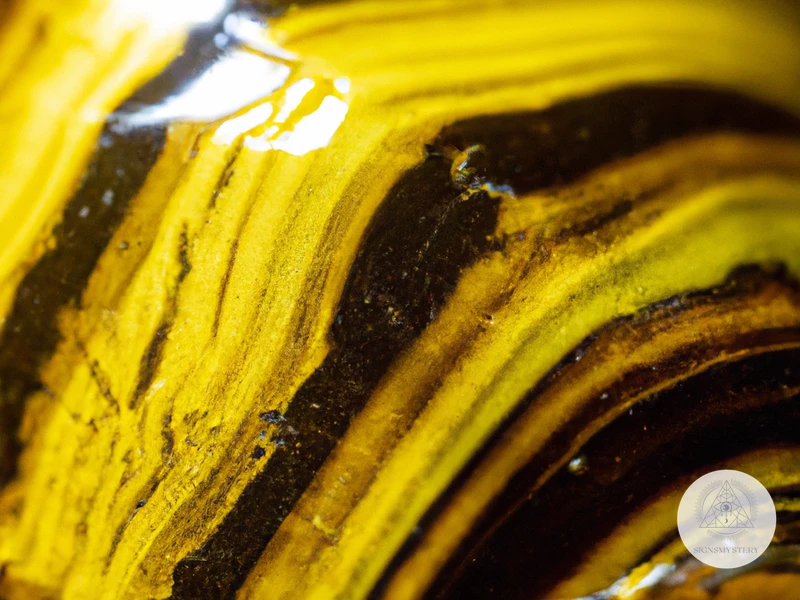Tiger’s Eye, a beautiful gemstone with a mesmerizing play of golden and brown colors, has captivated humans for centuries. This fascinating gemstone holds a rich past, steeped in ancient origins and intertwined with legends and mythology. Its geographical distribution spans across various corners of the world, from South Africa and Western Africa to Australia and India, as well as the United States and Canada. Understanding the formation and composition of Tiger’s Eye provides insights into its unique properties and cultural significance. From being used as amulets and talismans to its healing properties and symbolic representation, Tiger’s Eye has left an indelible mark in history. Today, it continues to enjoy widespread popularity for its modern uses. Join us on a journey through time to explore the captivating history and origin of Tiger’s Eye, a gemstone like no other.
Ancient Origins

Tiger’s Eye has its roots deeply embedded in ancient times, dating back thousands of years. The exact origins of this mesmerizing gemstone remain somewhat elusive, but it is believed to have first been discovered in Africa. The ancient civilizations that encountered Tiger’s Eye were captivated by its unique appearance and believed it possessed mystical powers. This gemstone was revered for its ability to evoke the spirit of the tiger, symbolizing courage, strength, and protection. Ancient cultures, such as the Egyptians, Romans, and Greeks, recognized the significance of Tiger’s Eye and incorporated it into various aspects of their lives, from jewelry to protective amulets. Through the centuries, the allure and symbolism of Tiger’s Eye have transcended time, making it a treasured gemstone with a rich history that continues to captivate people today.
Legends and Mythology
Legends and mythology surrounding Tiger’s Eye are as enchanting as the gemstone itself. In ancient Egyptian beliefs, Tiger’s Eye was associated with the powerful sun god Ra, representing the sun’s golden rays and its protective energy. It was believed to bring clarity, strength, and good fortune to its wearer. Additionally, Tiger’s Eye was revered by the Romans and Greeks, who believed that it could help them channel the inner strength and determination of a tiger. The gemstone was often worn or carried as a talisman during battles or important events for protection and courage. The unique chatoyancy displayed by Tiger’s Eye, resembling the eyes of a feline predator, further enhanced its association with strength and focus. These fascinating legends and mythological associations have added to the allure and allure of Tiger’s Eye throughout history.
Ancient Egyptian Beliefs
In ancient Egyptian culture, Tiger’s Eye held significant importance and was highly regarded for its protective qualities. The Egyptians believed that this gemstone had the power to ward off evil and bring good fortune to those who wore or carried it. They associated Tiger’s Eye with the goddess of the sun and protector of the pharaohs, Bastet. The striking golden-brown colors of Tiger’s Eye were seen as representative of the sun’s energy, and it was believed to possess the power of the sun god Ra. This gemstone was often used in the creation of jewelry, amulets, and statues. Egyptians would often carve intricate designs into Tiger’s Eye, enhancing its beauty and harnessing its protective properties. It was believed that Tiger’s Eye could provide strength, courage, and clear vision to those who possessed it. The Egyptians also used this gemstone in burial ceremonies, as they believed it could guide and protect the deceased in the afterlife. The reverence for Tiger’s Eye in ancient Egyptian culture highlights its significance and the deep belief in its metaphysical properties. Today, Tiger’s Eye continues to be embraced for its connection to the ancient Egyptians and its valuable symbolism in spiritual practices.
Roman and Greek Influences
The allure of Tiger’s Eye did not go unnoticed by the ancient civilizations of Rome and Greece. In fact, these cultures greatly influenced the significance of this mesmerizing gemstone. The Romans believed that Tiger’s Eye was a powerful talisman that provided protection against evil forces and promoted bravery and integrity. They would often engrave intricate designs on the stone and use it to create exquisite jewelry pieces, amulets, and even signet rings, symbolizing their social status and power. Similarly, the Greeks admired the stone’s captivating golden hues and associated it with the powerful god Apollo, who represented light, truth, and healing. They believed that Tiger’s Eye could provide clarity of thought and enhance one’s perception. It is no wonder that even today, Tiger’s Eye continues to be cherished for these very qualities, as it reminds us of the rich cultural influences that shape our appreciation for gemstones. To learn more about the dangers of fake crystals in the healing industry, click here.
Geographical Distribution

Tiger’s Eye can be found in various parts of the world, each with its own geological significance. South Africa and Western Africa, particularly countries like South Africa, Namibia, and Ghana, are known for their rich deposits of Tiger’s Eye. These regions have been mining and producing this gemstone for centuries. Australia is another significant source of Tiger’s Eye, especially the region of Western Australia. Additionally, India has also emerged as a notable producer of Tiger’s Eye, particularly in the state of Tamil Nadu. In recent years, the United States, particularly the states of California and Arizona, has also become a source of Tiger’s Eye. Canada, specifically in the province of Ontario, has also been known to produce this captivating gemstone. The diverse geographical distribution of Tiger’s Eye highlights its universal appeal and popularity throughout the world, making it a cherished and sought-after gemstone in various cultures and communities.
South Africa and Western Africa
South Africa and Western Africa are regions that have played a significant role in the geographical distribution of Tiger’s Eye. In South Africa, specifically in the Northern Cape Province, the gemstone is found in abundance. It is mainly sourced from the region around the town called Griquatown. The rich deposits of Tiger’s Eye in this area have been a major source of the gemstone for centuries.
In Western Africa, countries like Nigeria and Ghana have also been known for their Tiger’s Eye reserves. Nigeria is famous for its blue Tiger’s Eye, known as Hawk’s Eye, which exhibits a captivating blue hue alongside the characteristic golden and brown bands. These African countries have been instrumental in the supply of Tiger’s Eye gemstones to the global market.
The vastness of these regions has allowed for the mining and extraction of high-quality Tiger’s Eye. The gemstone is typically found in quartz veins and is formed through the alteration of crocidolite, a type of blue asbestos. This transformation process is what gives Tiger’s Eye its distinctive chatoyancy or “cat’s eye” effect, where it seems to shimmer and reflect light.
Today, South Africa and Western Africa continue to be important sources of Tiger’s Eye, contributing to its popularity in the gemstone market. The unique patterns and colors found in Tiger’s Eye from these regions make them highly sought after by collectors, jewelry designers, and enthusiasts alike. The connection between Tiger’s Eye and these African regions is a testament to the enduring allure and beauty of this remarkable gemstone.
Australia and India
Australia and India are two countries that have played significant roles in the geographical distribution of Tiger’s Eye. In Australia, this mesmerizing gemstone is primarily found in the Western Australian region, particularly in areas such as the Pilbara, Kimberley, and Gascoyne regions. The Australian Tiger’s Eye exhibits distinctive golden hues with a silky luster, making it highly sought after by gemstone enthusiasts. Indigenous Australians regard Tiger’s Eye as a sacred stone that holds spiritual significance. It is believed to provide protection and strength, harnessing the energy of the earth and the sun.
In India, Tiger’s Eye is found in the states of Tamil Nadu and Odisha. It is commonly referred to as “Kanak Khet” or “Kanak Khani” in India, which translates to “golden stone.” Indian Tiger’s Eye typically showcases a beautiful golden-brown color with a chatoyant effect, further enhancing its allure. In Indian mythology, Tiger’s Eye is associated with Lord Ganesha, the remover of obstacles and bestower of prosperity. It is often used in various rituals and ceremonies to invoke positive energies and bring good fortune.
Both Australia and India contribute to the global supply of Tiger’s Eye, with their unique geographical locations providing distinct characteristics to the gemstone. The rich cultural heritage of these countries adds to the mystique and reverence surrounding Tiger’s Eye, making it a prized gemstone for collectors and enthusiasts alike. Whether sought after for its aesthetic beauty, spiritual significance, or its energies, Tiger’s Eye from Australia and India continues to captivate individuals around the world.
United States and Canada
United States and Canada have also played a significant role in the geographical distribution of Tiger’s Eye. In the United States, Tiger’s Eye is primarily found in the western states, such as California, Nevada, and Arizona. These regions are known for their rich mineral deposits and have been a source of Tiger’s Eye for many years. In Canada, Tiger’s Eye can be found in a few provinces, including British Columbia and Ontario. The gemstone is often found in deposits along with other semiprecious stones, such as quartz and jasper.
One notable location in the United States where Tiger’s Eye is found is the state of South Dakota. The town of Custer in South Dakota is famous for its Tiger’s Eye deposits, attracting collectors and gemstone enthusiasts from all over. The rugged and picturesque landscapes of the Black Hills provide the perfect backdrop for mining and exploring this mesmerizing gemstone.
In Canada, the province of Ontario is known to have deposits of Tiger’s Eye. The Thunder Bay region, in particular, is renowned for its exquisite specimens of this gemstone. These deposits are believed to have formed from the alteration of volcanic rocks, creating the conditions necessary for the formation of Tiger’s Eye.
Both the United States and Canada have embraced the beauty and significance of Tiger’s Eye. This gemstone is not only cherished for its aesthetic appeal but also valued for its metaphysical properties. Crystal collectors and enthusiasts in these countries often incorporate Tiger’s Eye into their crystal collections, recognizing its protective and grounding energies.
The United States and Canada have become important contributors to the global distribution of Tiger’s Eye. The presence of this captivating gemstone in these regions adds to its allure and popularity worldwide. Whether used for personal adornment or in spiritual practices, Tiger’s Eye continues to captivate and enchant individuals across the globe.
Formation and Composition
Tiger’s Eye is a unique gemstone that forms through a fascinating process involving the transformation of another mineral called crocidolite. Crocidolite is a fibrous blue mineral that undergoes a process called pseudomorphosis, where its composition gradually changes while maintaining its original structure. During this transformation, iron oxide deposits replace the sodium in the crocidolite fibers, gradually turning it into a golden-brown mineral known as Tiger’s Eye. The interplay between the iron oxide and the original fibers creates the characteristic chatoyancy, or the shimmering effect, that gives Tiger’s Eye its distinctive appearance. The composition of Tiger’s Eye primarily consists of quartz, specifically a variety known as chalcedony, along with the embedded fibers of crocidolite. This unique composition gives Tiger’s Eye its stunning golden-brown color and captivating chatoyant effect. Understanding the formation and composition of Tiger’s Eye adds to its allure and makes it a sought-after gemstone for both its visual appeal and its perceived metaphysical properties.
Cultural Significance

The cultural significance of Tiger’s Eye spans across civilizations and is deeply intertwined with ancient beliefs and practices. In many ancient cultures, such as the Egyptians, Tiger’s Eye was considered a sacred stone that held powerful protective properties. It was believed to ward off evil spirits and bring good luck and prosperity to its wearer. The Egyptians also associated Tiger’s Eye with the powerful solar deity Ra, emphasizing its connection to the sun and its radiant energy. Similarly, in Roman and Greek mythology, Tiger’s Eye was associated with the goddess of the hunt, Artemis, and the god of war, Mars, respectively, symbolizing courage and strength. Beyond its protective qualities, Tiger’s Eye was also used in various forms of adornment, including amulets and talismans, to provide a sense of grounding and stability. Today, Tiger’s Eye continues to be highly valued for its cultural significance and the metaphysical properties it is believed to possess, making it a popular choice among crystal enthusiasts.
To learn more about the benefits of building a crystal collection and how to store crystal grids effectively, check out this helpful guide on the benefits of storage grids for your crystal collection. Additionally, if you’re interested in cleansing your crystals and harnessing their power through visualization, you can find valuable information in this guide on how to cleanse crystals and enhance your intentions through visualization.
Amulets and Talismans
Amulets and talismans have played a significant role in many ancient cultures, and Tiger’s Eye was highly prized for its protective qualities. In ancient times, artisans would carve Tiger’s Eye into intricate shapes resembling animals or symbolic figures to create powerful talismans. These talismans were believed to harness the energy and strength of the tiger, offering the wearer courage and protection against negative energies. The Egyptians, for instance, used Tiger’s Eye in their jewelry and amulets, considering it a stone of divine vision and insight. It was believed to provide clarity and protection, especially during times of uncertainty and danger. The Romans and Greeks also admired Tiger’s Eye, often incorporating it into their jewelry and personal ornaments as a symbol of power and prestige. Today, Tiger’s Eye continues to be revered as a protective stone and is often worn as jewelry or carried as a talisman to attract good luck and ward off negative energies. It serves as a reminder of the inner strength and resilience we all possess, just like the majestic tiger.
Healing Properties
The healing properties of Tiger’s Eye have fascinated individuals throughout history. This gemstone is believed to possess a variety of metaphysical properties that can promote emotional well-being and balance. One of the most notable healing properties of Tiger’s Eye is its ability to instill confidence and boost self-esteem. It is believed to help individuals overcome self-doubt and face challenges with
Subscribe to Our Newsletter
Sign up to receive the latest news and updates.
Symbolism
Symbolism plays a significant role in understanding the cultural significance of Tiger’s Eye throughout history. This captivating gemstone holds deep symbolic meanings in various ancient civilizations. In Egyptian mythology, Tiger’s Eye was associated with the powerful sun god Ra, representing the divine solar energy and radiating strength. It was believed to provide protection against evil and promote clarity of thought. The Roman and Greek cultures also held Tiger’s Eye in high regard, associating it with the tiger and the goddess of the hunt, Artemis. In these cultures, the gemstone was regarded as a talisman of courage, confidence, and focus. Its mesmerizing golden and brown hues symbolized the earthy energy and grounding forces.
Tiger’s Eye symbolized balance and harmony, helping individuals find their inner equilibrium and stay centered in tumultuous times. This gemstone was also connected to the concept of spiritual growth, encouraging the exploration of one’s inner self and the development of intuition. Its chatoyant effect, resembling the eye of the tiger, symbolized keen observation, awareness, and foresight.
In addition to its spiritual symbolism, Tiger’s Eye was believed to attract good luck and prosperity. Many cultures considered it to be a stone of abundance, enhancing one’s ability to manifest wealth and opportunities. This belief stemmed from its association with the solar energy and the divine energies that govern the universe.
The symbolism of Tiger’s Eye represents a powerful connection to ancient beliefs and philosophies. It continues to be cherished for its potent symbolic meanings, making it a popular choice for those seeking guidance, balance, and protection in their lives.
Modern Uses and Popularity
In modern times, Tiger’s Eye continues to enchant people with its unique beauty and symbolism. Its allure is not limited to its aesthetic appeal; rather, it has gained popularity for its various uses and applications. One of the most common modern uses of Tiger’s Eye is in jewelry. Its golden-brown bands and chatoyancy make it a sought-after gemstone for necklaces, bracelets, earrings, and rings. The warm hues of Tiger’s Eye add a touch of elegance and sophistication to any jewelry piece.
Beyond jewelry, Tiger’s Eye has found its way into various decorative items and home decor. With its rich colors and intriguing patterns, it is often used in sculptures, carvings, and ornamental objects. Its distinct appearance adds a touch of natural beauty to any space, making it a popular choice among interior decorators and enthusiasts.
Tiger’s Eye is also revered for its metaphysical properties and is widely used in crystal healing practices. It is believed to have grounding and protective energies, helping individuals stay centered and ward off negative influences. Many people use Tiger’s Eye during meditation and spiritual practices to enhance focus and promote a sense of stability and strength.
Tiger’s Eye is a favored gemstone among collectors. Its uniqueness and historical significance make it a prized addition to any crystal collection. The demand for authentic Tiger’s Eye has grown in recent years, but so has the prevalence of fake or synthetic versions. Collectors and enthusiasts must exercise caution and ensure they source their Tiger’s Eye from reputable sources to avoid falling prey to counterfeit products.
The modern uses and popularity of Tiger’s Eye extend far beyond its captivating appearance. From adorning jewelry pieces to enhancing home decor and promoting well-being through crystal healing, this gemstone continues to hold a significant place in the hearts of many. Its timeless charm, combined with its cultural and metaphysical significance, ensures that Tiger’s Eye will remain a cherished gemstone for generations to come.
Closing Thoughts

In closing, the history and origin of Tiger’s Eye provide a fascinating glimpse into the world of gemstones and their cultural significance. From its ancient origins to its widespread popularity in the modern era, Tiger’s Eye has truly stood the test of time. Its unique composition and mesmerizing appearance continue to captivate jewelry enthusiasts and gemstone collectors alike. Whether it be for its symbolic representation of courage and strength or its alleged healing properties, Tiger’s Eye holds a special place in human history. As we delve into the past and unravel the mysteries surrounding this captivating gemstone, we come to appreciate the rich tapestry of beliefs and traditions that have been woven together throughout the centuries. So, the next time you admire a piece of Tiger’s Eye jewelry or come across this gemstone in your travels, take a moment to reflect on its ancient origins and the remarkable journey it has made from the distant past to the present day.
Frequently Asked Questions
1. What makes Tiger’s Eye unique?
Tiger’s Eye is renowned for its chatoyancy, a fascinating optical phenomenon that creates a golden or brownish band of light running parallel to its surface. This unique feature gives Tiger’s Eye its distinct appearance.
2. How was Tiger’s Eye formed?
Tiger’s Eye is formed through a process known as pseudomorphic replacement. It begins as fibrous blue crocidolite, and over time, as quartz deposits replace the crocidolite, the transformation into Tiger’s Eye occurs.
3. What are the colors of Tiger’s Eye?
Tiger’s Eye typically displays a combination of golden and brown hues, reminiscent of the colors of a tiger’s fur. The golden shade is caused by the presence of iron, while the brown coloration is due to the oxidation of the mineral.
4. How durable is Tiger’s Eye?
Tiger’s Eye is a relatively durable gemstone, with a hardness rating of 7 on the Mohs scale. It is suitable for everyday wear, but care should be taken to avoid rough abrasion or exposure to harsh chemicals.
5. Can Tiger’s Eye be treated or enhanced?
Tiger’s Eye is known for its natural beauty and is rarely treated or enhanced. However, some lower-grade specimens may undergo heat treatment to enhance their color or clarity.
6. What cultural significance does Tiger’s Eye hold?
Tiger’s Eye holds significant cultural importance in various ancient civilizations. It was believed to bring protection, courage, and good fortune. Many cultures also associated Tiger’s Eye with the power of the sun, making it a revered gemstone.
7. How can Tiger’s Eye be used for spiritual purposes?
Many believe that Tiger’s Eye possesses metaphysical properties that promote balance, confidence, and strength. It is often used in meditation, visualization practices, and as a talisman for protection.
8. Can Tiger’s Eye be used for jewelry?
Absolutely! Tiger’s Eye is commonly used in jewelry, such as rings, earrings, pendants, and bracelets. Its unique chatoyancy adds a touch of elegance and intrigue to any piece.
9. What are the popular alternatives to Tiger’s Eye?
Some popular alternatives to Tiger’s Eye include Hawk’s Eye, which is blue-gray in color, and Cat’s Eye, which displays a band of light similar to Tiger’s Eye but comes in a range of colors.
10. How can I care for and clean my Tiger’s Eye jewelry?
To keep your Tiger’s Eye jewelry looking its best, clean it gently with warm soapy water and a soft brush. Avoid exposing it to harsh chemicals and store it separately to prevent scratching from other jewelry pieces.
References
Frequently Asked Questions
What is Tiger’s Eye?
Tiger’s Eye is a captivating gemstone that displays a unique chatoyancy effect. It is a type of quartz with a golden to reddish-brown color and striking bands of light that resemble a tiger’s eye.
How does Tiger’s Eye get its name?
Tiger’s Eye derives its name from its distinctive appearance, which resembles the eye of a tiger. The stone’s color and chatoyancy pattern resemble the cat’s eye, hence the name.
Where does Tiger’s Eye come from?
Tiger’s Eye is found in various regions around the world, including South Africa, Western Africa, Australia, India, and even parts of the United States and Canada.
What are the ancient origins of Tiger’s Eye?
Tiger’s Eye has been revered for centuries and has ancient origins. It was used by ancient civilizations such as the Egyptians, Greeks, and Romans for its believed protective and spiritual properties.
What are the legends and mythology linked to Tiger’s Eye?
In ancient Egyptian beliefs, Tiger’s Eye was associated with the sun god Ra and was believed to provide protection and courage. The Romans and Greeks also held the stone in high regard and believed it could bring them both wealth and bravery.
What is the composition of Tiger’s Eye?
Tiger’s Eye is primarily composed of quartz, which is a mineral made of silicon and oxygen. It also contains traces of iron, which give it its distinctive golden to reddish-brown color.
What cultural significance does Tiger’s Eye hold?
Tiger’s Eye holds cultural significance in various traditions. It has been used as an amulet or talisman for protection and good luck. Additionally, its healing properties have been acknowledged, and it is regarded as a stone of strength and confidence.
What are the modern uses of Tiger’s Eye?
Today, Tiger’s Eye is widely used in jewelry-making and is a popular gemstone choice for both men and women. It is also used as a decorative stone in various crafts and has gained popularity as a stone for meditation and energy healing.
Does Tiger’s Eye have any healing properties?
According to holistic practices, Tiger’s Eye is believed to have several healing properties. It is said to promote clarity of thought, enhance intuition, and help in achieving one’s goals. It is also thought to provide protection against negative energies.
What symbolism is associated with Tiger’s Eye?
Tiger’s Eye symbolizes strength, courage, and confidence. It is often associated with the qualities of a tiger, such as perseverance and determination. The stone is believed to inspire inner strength and empower the wearer to overcome obstacles.
References
- Everything You Need To Know About Tigers Eye Gemstone!
- Tigers Eye – Gemstone
- Gemstone – Tiger Eye, its Meaning, History and Uses – MYKU










